Motorola Rokr
The Motorola Rokr (/ˈrɒkər/, styled ROKR), the first version of which was informally known as the "iTunes phone", was a series of mobile phones from Motorola, part of a 4LTR line developed before the spin out of Motorola Mobility. Rokr models were released starting in September 2005 and ending in 2009. They were notable for incorporating support of media player features.
E1
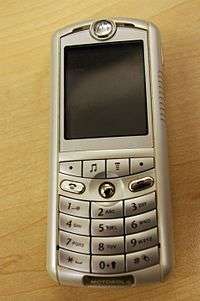 | |
| Compatible networks | GPRS |
|---|---|
| Dimensions | 108 × 46 × 20.5 mm |
| Mass | 107 g |
| Memory | microSD |
| Display | 176×220 pixels, 262,000 colors |
| Connectivity | Bluetooth |
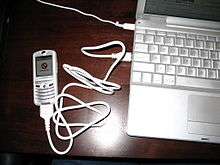
Launched on September 7, 2005 in San Francisco, California, the E1 is the first phone to be integrated with Apple's iTunes music player, the next phone being the first iPhone in 2007. The phone had been widely expected, with technology sites reporting on collaborations between Motorola and Apple as far back as December 2004.
Description and acceptance
The Rokr E1 is a re-badged Motorola E398 candybar style phone (it was originally called the E790) with Apple-licensed technology to play back iTunes Music Store purchased music. It features a music player with an interface similar to that of Apple's iPod music players. Since hardware on Motorola E398 and Rokr E1 phones are the same, it is possible to crossflash Motorola Rokr E1's firmware to Motorola E398 using phone flashing software like flash & backup.
While the phone equipped an upgradeable 512 MB microSD memory card (Max. 1 GB), its firmware allowed only up to 100 songs to be loaded at any time.[1] The limit hurt the Rokr's appeal. Many users also discovered that transferring music to the phone was slow compared to dedicated players, due to lack of support for Hi-Speed USB, and the E1 lacked wireless transfer.[2] The Rokr was also criticized for being too much like the preceding E398. As a result, the Rokr E1 sold below expectations despite a high-profile marketing campaign.[3]
Because of the iPod nano unveiling on the same day, relations between Motorola and Apple were strained and Motorola CEO Ed Zander later accused Apple of purposely undercutting the Rokr.[4]
The Rokr E1 was replaced by the E2 (see below), which lacked iTunes support and was superseded by the iTunes-enabled SLVR L7.
E2
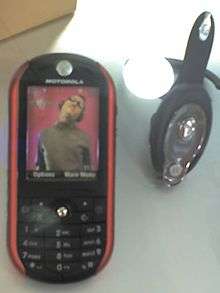 | |
| Compatible networks | GSM 900/1800/1900 with GPRS Class 10 (2U/4D) |
|---|---|
| Availability by region | |
| Dimensions | 106 × 49.5 × 18 mm |
| Mass | 115 g |
| CPU | Intel XScale PXA270 |
| Storage | 11 MB |
| Removable storage | SD expansion card slot for up to 2 GB (or 4 GB, if flashed with modded firmware) |
| Display | 30 × 40 mm TFT LCD, 240×320 pixels, 262K colours |
| Rear camera | 1.3-megapixel, video at 15 fps for 2 hours maximum |
| Connectivity | • Bluetooth 2.0 + EDR (supports A2DP) • USB 2.0 by mini-USB |
The E2 was released in January 2006. Instead of iTunes, the phone came bundled with RealPlayer, supporting a larger variety of formats. It also featured a music control panel on the left side of the phone. Users can also listen to stereo FM radio with Motorola Rokr E2. By using iRadio, FM radio programs can also be downloaded into the phone through internet, letting users listen to the radio at any time. The first public release occurred on June 22, 2006 in China.[5][6]
Features
- Talk time: up to 9 hours
- Standby time: up to 8 days
- Multimedia playback: MP3, AMR, MID, MIDI, SMF, MMF, XMF, IMY, WAV, RA, WMA, AAC, AWB, MPGA, M4A, 3GA, RM, RMVB, 3GP, MP4 by RealPlayer
- Audio connector: 3.5 mm headset jack
- Java support: MIDP 2.0, CLDC 1.1, HEAP 2mb
- Browser: Opera 8.50 with e-mail support
- Local connectivity:
As a Linux-based phone, the open source community developed numerous modifications to the phone's software, such as quad band, EDGE, and support for a 4 GB SD card. Some have overclocked the processor.
E6
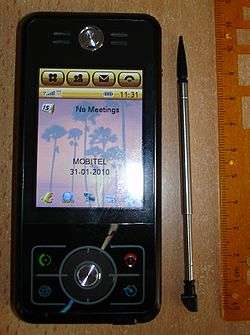 | |
| Manufacturer | Motorola |
|---|---|
| Series | Motorola Rokr |
| Compatible networks | GSM Tri-band (900/1800/1900, hackable to Quad-band) |
| Availability by region | November 14, 2006 (China) December 4, 2006 (Worldwide) |
| Dimensions | 111 × 51.5 × 14 mm (82 cc) |
| Mass | 122 g |
| Operating system | MontaVista Linux OS (not MOTOMAGX) |
| CPU | Intel XScale-PXA27x rev 7 (v5l) |
| Memory | 46 MB RAM (50% free after boot-up) |
| Storage | 120 MB (most modern phones have more) |
| Removable storage | SD/MMC expandable to 4 GB (New patch) |
| Battery | Li-ion 1000 mAh |
| Data inputs | Touchscreen with stylus |
| Display | 2.4 in diagonal touch TFT LCD, 262k colors, 240×320 pixels |
| Rear camera | 2 megapixels + Macro Mode |
| Connectivity | • GPRS Class 10 • BCM2045 Bluetooth 2.0 (+A2DP) • 3.5 mm Stereo/Mic Jack • Enhanced Mini USB |
The E6 was released in China on November 14, 2006, and subsequently worldwide on December 4, 2006.
The Rokr E6 is a direct descendant of the E680 and the MING, sharing the same Montavista Linux operating system, Intel XScale PXA270 series processors, and the RealPlayer media player instead of the iTunes player installed on the first Rokr phone. The E6 features a built-in FM radio, (but no radio recording). It also inherited the 2-megapixel camera with manual macro-switching and business card recognition from MING, enhanced with QR Code recognition functions. Additionally, the phone features a 3.5 mm headphone jack, allowing use of a standard-sized headphone plug.
It comes installed with Picsel Viewer with the ability to read Microsoft Office and PDF file formats.
Details
The phone is part of Motorola's line of phones running Linux, this one using a modified 2.4.20 kernel. This has upset some, as they broke the GPL in not releasing the kernel source code.[7] The software is an updated version of MING (Motorola A1200), with a different file system. Most of the apps that work on the MING work on the E6, but some may not due to the file system. Normally the phone only runs on tri-band GSM networks, though some have found an exploit to get it to run on Quad Band networks and over Edge.[8] The radio channel frequency can also be modified beyond 88 MHz to 65 MHz, and the preset number of channels can also be modified.
Technical specifications
| Battery Life | Up to 7 hours talk time - about 235 hours standby |
| Web Camera | Yes, via USB |
| Voice Recording | Yes (.amr) |
| Video Recording | Yes, up to CIF 352×288 (.3gp) |
| Maximum number of Sockets | 10 |
| Browsers | Opera Mini with support for HTTP, HTTPS, Socket, Secure Socket, UDP |
| Image Support | .PNG, .GIF, .BMP, .JPEG, .EMS, .WMP |
| Encoding schemes | USASCII, UTF-8 (Unicode), UTF-16 with explicit Byte Order Mark (Part of IOP), UCS-2 |
| Messaging | SMS, MMS |
| POP3, IMAP4, SMTP | |
| Java | Yes, CLDC v1.1 and MIDP v2.0 compliant |
| FCC ID | Yes[9] |
Z6
| Manufacturer | Motorola |
|---|---|
| Compatible networks | GSM quad-band with EDGE |
| Predecessor | Motorola Rizr Z3 |
| Successor | Motorola Rizr Z8 |
| Dimensions | 105.5 × 45.5 × 16 mm |
| Mass | 115g / 4.06 ounces |
| Operating system | MOTOMAGX |
| CPU | Freescale MXC275-30 32-bit 528 MHz ARM11 |
| Memory | 64 MB available to user, 96 MB ROM, 64 MB SDRAM |
| Removable storage | microSD (TransFlash) card up to 2 GB |
| Battery | BC50 3.7V at 750mah |
| Display | 2.1 in diagonal TFT LCD, 320×240 px, 262,000 colors |
| Rear camera | 2.0 MPix with LED flash |
| Connectivity | • mini-USB • Bluetooth (Class 2) + A2DP |
The Z6, originally known as the Rizr Z6, was released on July 7, 2007. The Z6 features Motorola's new version of the embedded Linux-based operating system, MOTOMAGX. It also supports stereo Bluetooth technology (A2DP) and features a 2-megapixel digital camera. The Z6 also supports synchronisation with Windows Media Player 11, allowing playlists and audio to be transferred to the phone's internal memory, which can in turn be transferred onto a compatible microSD memory card. The phone does not support 3G or HSDPA, relying on EDGE for data.
Audio format support
The Z6 supports the following audio formats:
Z6m
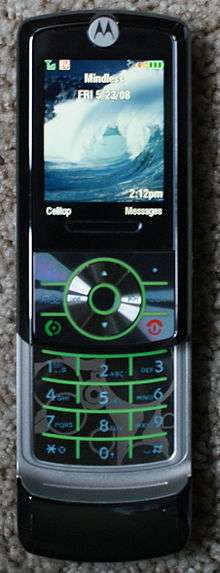 | |
| Compatible networks | CDMA 800/1900 1xEV-DO r0 data speed |
|---|---|
| Dimensions | 105.5 × 45.5 × 16 mm |
| Mass | 115 g / 4.06 ounces |
| Operating system | BREW, Paragon 2005 (P2K05) Internal Filesystem |
| Memory | 14 MB |
| Removable storage | Supports microSD (TransFlash) memory cards: • 512 Mb card included; • Upgradeable to 2 GB. |
| Display | 2 in diagonal TFT LCD, 320×240 px, 65,536 colors |
| Connectivity | mini-USB, Bluetooth (Class 2), EV-DO |
The Z6m is the CDMA version of the Rokr Z6. The Rokr Z6m comes with an integrated music player, 3.5 mm headset jack, stereo Bluetooth, a 512 MB MicroSD card in its respective slot, a key lock switch, and a 2-megapixel digital camera. The phone supports up to 2 GB of removable storage.
Unlike the Z6, the Z6m does not run MotoMAGX, a version of Linux, but instead runs the Binary Runtime Environment for Wireless operating system, also known as BREW.
U.S. Cellular was the first carrier to release the Rokr Z6m on October 14, 2007 alongside their Napster-to-Go service's launch.
Technical information
When connected to a computer via USB and the connection type is set to "Modem/COM", the phone acts like a USB serial peripheral, allowing Motorola Phone AT Commands to be sent. In this mode, sending "AT+MODE=8" will put the phone into a different state, in which it no longer accepts AT commands but its P2K05 functionality is accessible.
W5
| Mass | 107 g |
|---|---|
| Memory | 20 MB internal microSD up to 2 GB |
| Display | 176x220, 256K colors |
| Rear camera | 1.3 MP |
The W5 was released in September 2007. The phone features up to 2 GB through a microSD slot, a 1.3-megapixel camera, Motorola's P2K OS, and a music player.
E8
| Manufacturer | Motorola |
|---|---|
| Compatible networks | GPRS |
| Availability by region | July 2008 |
| Predecessor | Rokr E6 |
| Successor | Rokr EM30 |
| Dimensions | 115 mm × 53 mm × 10.6 mm |
| Mass | 100 g |
| CPU | 500MHz Freescale SCM-A11 |
| Memory | 2 GB internal memory and microSD(up to 10 GB with SDHC) |
| Battery | Li-ion 970 mAh |
| Display | Type: TFT; Colors: 250K; Size: 320 x 240 pixels (2 inches) |
| Rear camera | 2 megapixel, 8x zoom |
| Connectivity | mini-USB, 3.5 mm headphone jack, Bluetooth Class 2 |
The E8 was released in July 2008. It features a new keypad interface called ModeShift, which automatically changes the context of the keypad depending on the current function of the device. It also features a localized touch feedback system with haptic technology that gives the feeling of real buttons, though the keyboard surface is smooth. It will sync with Microsoft Outlook, but not with Web or Mac based calendars.
Both E8 and EM30 uses the ModeShift technology and this enables the phone to switch from talk to music with one touch (special music keys light up when playing music) Coupled with in-build CrystalTalk technology (a Motorola patent), crisp and clear conversations is possible in noisy environments.
Carriers
Specifications
The complete Motorola Rokr E8 list of specifications are:[10]
| Type | Specification |
|---|---|
| Battery Life | Talk: 7 hours; Standby: 300 hours |
| Phone Book Capacity | Unlimited (limited only by memory capacity) |
| Video Capture | .MOV 176*144 @15 frame/s |
| Email Client | Protocols Supported: POP3, IMAP4, SMTP |
| EMS / Picture Messaging | EMS 5.0 |
| Java ME | Version: MIDP 2.0 |
| Predictive Text Entry | Technology: iTAP |
| Text Messaging | 2-Way |
| Voice Dialing | speaker-independent |
| Wireless Internet | WAP 2.0, xHTML, HTML |
| FM Radio | Yes |
| Alarm | Yes |
| Calculator | Yes |
| Calendar | Yes |
| Custom Graphics | Yes |
| Data-Capable | Yes |
| Digital TTY/TDD | Yes |
| Games | Yes |
| MMS | Yes |
| Multiple Languages | Yes (English, French, Chinese, Spanish) |
| Multiple Numbers per Name | Yes |
| PC Sync | Yes |
| Picture ID | Yes |
| Polyphonic Ringtones | Yes |
| Ringer ID | Yes |
| Side Keys | Yes |
| Speaker Phone | Yes |
| Text Messaging Templates | Yes |
| Vibrate | Yes |
| Voice Memo | Yes |
EM30
| Manufacturer | Motorola |
|---|---|
| Compatible networks | GSM 850/ 900/ 1800/ 1900 |
| Availability by region | August 5, 2008 |
| Predecessor | Motorola Rokr E8 |
| Successor | Aura |
| Dimensions | 115 mm × 53 mm × 10.6 mm |
| Mass | 100 g |
| Memory | 18.5 MB RAM |
| Battery | Li-ion 970 mAh |
| Display | Type: TFT; Colors: 250K; Size: 240 x 320 pixels (2 inches) |
| Rear camera | 2 megapixel, 8x zoom |
| Connectivity | mini-USB, 3.5 mm headphone jack, Bluetooth Class 2 |
The EM30, releasing in August 2008, was the lower-end version of the E8 (see above), without the FastScroll navigation wheel and the haptics feel.
EM30 is running on LiMo Platform, a Linux-based operating system for mobile devices. It is the 22nd LiMo Handset.[11]
Both E8 and EM30 uses the ModeShift technology and this enables the phone to switch from talk to music with one touch (special music keys get lighted up when playing music) The phone incorporated Motorola's patented CrystalTalk technology, providing clear conversations in noisy environments.
Specifications
- Messaging: MMS, EMS 5.0, email (POP3, SMTP, IMAP4), Motosync for corporate email support
- Connectivity method: Stereo Bluetooth Class 2, 3.5mm, USB 2.0 HS, Mobile Phone Tools, Over the Air Sync (OTA), PC Sync
- Dual Transfer Mode (DTM): Enables GPRS during call; operator dependent
- Camera: 2 MP, Digital Zoom, Fixed Focus, take up to 8 multi shot pictures
- Capture/Playback/Streaming: H.263, MPEG4, WMV v9
- Audio: MIDI, MP3, AAC, AAC+, Enhanced AAC+, WMA, WAV, AMR-NB, Real Audio (RA) v10
- FM Radio: with Radio Data System (RDS) 3
- Keypad: Backlight morphing keypad that changes color from phone mode to music mode
- Airplane Mode: Uninterrupted music up in the plane/play music
- 3.5mm headset
- 3D Stereo Sound
- Memory: 30 MB internal memory, optional 8 GB microSDHC support
- Microsoft Music Ecosystem Support (sync music with Windows Media Player)
- Audio Playback: Target 16 hours (Airplane Mode)
- Crystal Talk technology for noise cancellation
- Text to speech recognition
Technical specifications
- Bands/Modes: Quad Band
- Dimensions: 115x53x10.6mm
- Display: 2.0˝ QVGA 240x320 262K TFT
- Form Factor: Bar with internal antenna
- GPRS Class 12: EDGE class 12
- Audio Playback Time: up to approximately 16 hours
- Size: 60cc
- Standby Time: up to approximately 300 hours
- Talk Time: up to approximately 360 minutes
- Weight: 100g
- Airplane Mode: listen to music, take pictures, play games on the plane, with the RF off
EM326g
| Memory | microSD(up to 2 GB) |
|---|---|
| Rear camera | 1.3 MP |
The EM326g was released in January 2009. It is the first ROKR phone to be available pre-configured for use with a prepaid network (Net10).
EM35
| Manufacturer | Motorola |
|---|---|
| Availability by region | Q1 2009 |
| Predecessor | Rokr EM30 |
| Mass | 116 g |
| Memory | 110 MB RAM |
| Display | 320x240 pixels, TFT LCD, 256K colours |
| Rear camera | 3.15 megapixel |
The EM35 was released in Q1 2009. It had a 3.15 MP camera, 110 MB internal memory, and a microSD card slot supporting up to 16 GB.
W6
| Mass | 107 g |
|---|---|
| Memory | 20 MB internal microSD up to 2 GB |
| Display | 176x220, 256K colors |
| Rear camera | 1.3 MP |
The W6 was released in April 2009.
ZN50/ZN500
| Mass | 143 g |
|---|---|
| Memory | microSD up to 16 GB |
| Display | 240x427, 256K colors, TFT LCD touchscreen |
| Rear camera | 3.15 MP with auto-focus |
The ZN50 was released in July 2009 as a high-end phone in the Rokr series. It featured a 3.15 MP camera with auto-focus, improved screen resolution, a touchscreen and storage expandable up to 16 GB.
EM25/EM325
| Mass | 90g |
|---|---|
| Memory | microSD up to 2 GB |
| Display | 128x160, 65K colors, TFT LCD |
| Rear camera | 1.3 MP |
The EM25/EM325 was released in July 2009, at the same time as the ZN50 (see above).
EM28/EM330
| Manufacturer | Motorola |
|---|---|
| Availability by region | July 2009 |
| Form factor | Clam / Flip |
| Dimensions | In inches: 4.1mm x 2.1mm x 0.6mm |
| Mass | 90g (with battery) |
| Memory | 30MB |
| Removable storage | microSD (up to 2 GB) |
| Battery | Lithium ion battery, Talk time: Up to 7 hrs, Stand-by: Up to 23 days |
| Display | 65K color, 128 x 160 pixels |
| Rear camera | 1.3 MP |
| Connectivity | Bluetooth |
The Motorola EM28/EM330 was released in July 2009, at the same time as the ZN50 and EM25/EM325 (see above).
Specifications
- 1.3-megapixel camera
- Bluetooth
- Video Playback & Streaming Video
- Voice Recorder (60seconds limited)
- Calculator, Calendar, and Alarm Clock
- Vibrating, Games and Sync
- Volume Control
- Cellular Video
- SMS, MMS, EMS, and Chat
- Dual band GSM 850/1800/1900 MHz
- Weight: 90g (with battery)
- 65K colour, 128fg
- MMS
- Video Recorder
- FM Radio: RDS Radio
- MP3 Player (AT&T Mobile Music / MusicID)
- SMS text messages
- MMS messaging with pictures
- EMS
- Photo and data sharing with Bluetooth 2.0
- Mini-USB port for connection with PC
- WAP 2.0 web browser
- Battery: Lithium-ion
- Talk time: Up to 7 hours
- Stand-by: Up to 23 days
References
- "It's official: Rokr E1 iTunes phone can only store max. 100 tracks". Engadget. Sep 8, 2005. Retrieved 2010-11-17.
- Tynan, Dan (2006-05-26). "The 25 Worst Tech Products of All Time". PC World. Retrieved 2013-03-22.
- "Moto Blasts iRadio". Red Herring. 2 January 2006. Archived from the original on 2011-06-07. Retrieved 2013-03-22.
- Andreescu, Alex (27 September 2005). "iPod nano: The End of the Motorola-Apple Story - Ed Zander, Motorola CEO: "Screw the nano"". Softpedia. Retrieved 2010-06-05.
- Ziegler, Chris (2006-06-23). "China first to get Motorola Rokr E2". Engadgetmobile.com. Retrieved 2013-03-22.
- "Music to Retailer's Ears: Motorola Next Generation Music Device Rokr E2 Makes Smash Debut at GOME". Prnewswire.com. 2006-06-21. Retrieved 2013-03-22.
- "First Release of Rokr E6 Source Available". opensource.motorola.com.
- "EDGE and Quad-Band". Rokitrokr-edge.blogspot.com. 2006-07-11. Retrieved 2013-03-22.
- Ziegler, Chris (Oct 19, 2006). "Motorola ROKR E6 gets FCC blessing". engadgetmobile.com. Retrieved 2013-03-22.
- "Motorola E8 specifications". Gsmarena.com. Retrieved 2013-03-22.
- "Motorola's New Rokr EM30 Becomes 22nd LiMo Handset". limofoundation.org. Archived from the original on 2008-12-05.